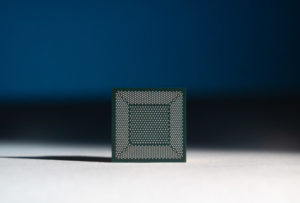Neuromorphic chips attempt to directly mimic the behavior of the human brain. Intel, which introduced its Loihi neuromorphic chip in 2017, has just announced that Loihi has been scaled up into a system that simulates over 100 million neurons. Furthermore, it announced that the chip smells. (That is to say: it’s able to smell. To a nose, it probably just smells like a computer chip.)

Loihi is Intel’s fifth-generation neuromorphic chip. It packs 128 cores – each of which has a built-in learning module – and a total of around 131,000 computational “neurons” that communicate with one another, allowing the chip to understand stimuli. The new system, Pohoiki Springs, contains over 100 million of those computational neurons. It consists of 768 Loihi chips, mounted on Intel Nahuku boards in a chassis that Intel describes as “the size of five standard servers,” and a row of Arria10 FPGA boards. By contrast, Kapoho Bay, Intel’s smallest neuromorphic device, consists of just two Loihi chips with 262,000 neurons.
“Pohoiki Springs scales up our Loihi neuromorphic research chip by more than 750 times, while operating at a power level of under 500 watts,” said Mike Davies, director of Intel’s Neuromorphic Computing Lab. “The system enables our research partners to explore ways to accelerate workloads that run slowly today on conventional architectures, including high-performance computing systems.”
Pohoiki Springs isn’t ready for real-world use cases just yet, with Intel initially making it available via cloud to members of the Intel Neuromorphic Research Community (INRC), which is made up of academic, government and industry research groups. Intel does, however, cite a number of promising applications for systems like Pohoiki Springs, including constraint satisfaction problems (such as delivery logistics), graph searches and optimization problems.
And also, of course, they taught it to smell.
Teaching Loihi to smell
A joint effort between Intel Labs and Cornell University put Intel’s neuromorphic research chip, Loihi, to the test by teaching it how to recognize a variety of smells in a chaotic environment. The researchers created a dataset by pumping ten hazardous chemicals (including acetone, ammonia and methane) through a wind tunnel, where a set of 72 chemical sensors collected signals. Then, the researchers leveraged Loihi and a neural algorithm designed to mimic the brain’s olfactory circuits to train the chip to recognize all ten of those hazardous chemicals by smell.

“My friends at Cornell study the biological olfactory system in animals and measure the electrical activity in their brains as they smell odors,” said Nabil Imam, a senior research scientist in Intel Labs’ neuromorphic computing group. “On the basis of these circuit diagrams and electrical pulses, we derived a set of algorithms and configured them on neuromorphic silicon, specifically our Loihi test chip.”
Intel reported that the chip quickly learned to understand all ten smells using just a single sample of each and was able to pinpoint them, even when obfuscating factors were introduced. Furthermore, they reported that the chip outperformed a deep learning solution that required thousands of times more training samples per subject. Imam knows that this is just a start, but hopes that the research is a stepping stone to robust, scalable solutions in the future.
“These are challenges in olfactory signal recognition that we’re working on and that we hope to solve in the next couple of years before this becomes a product that can solve real-world problems beyond the experimental ones we have demonstrated in the lab,” said Imam.
“My next step,” he continued, “is to generalize this approach to a wider range of problems — from sensory scene analysis (understanding the relationships between objects you observe) to abstract problems like planning and decision-making. Understanding how the brain’s neural circuits solve these complex computational problems will provide important clues for designing efficient and robust machine intelligence.”
Header image: Pohoiki Springs. Image courtesy Intel.




























































